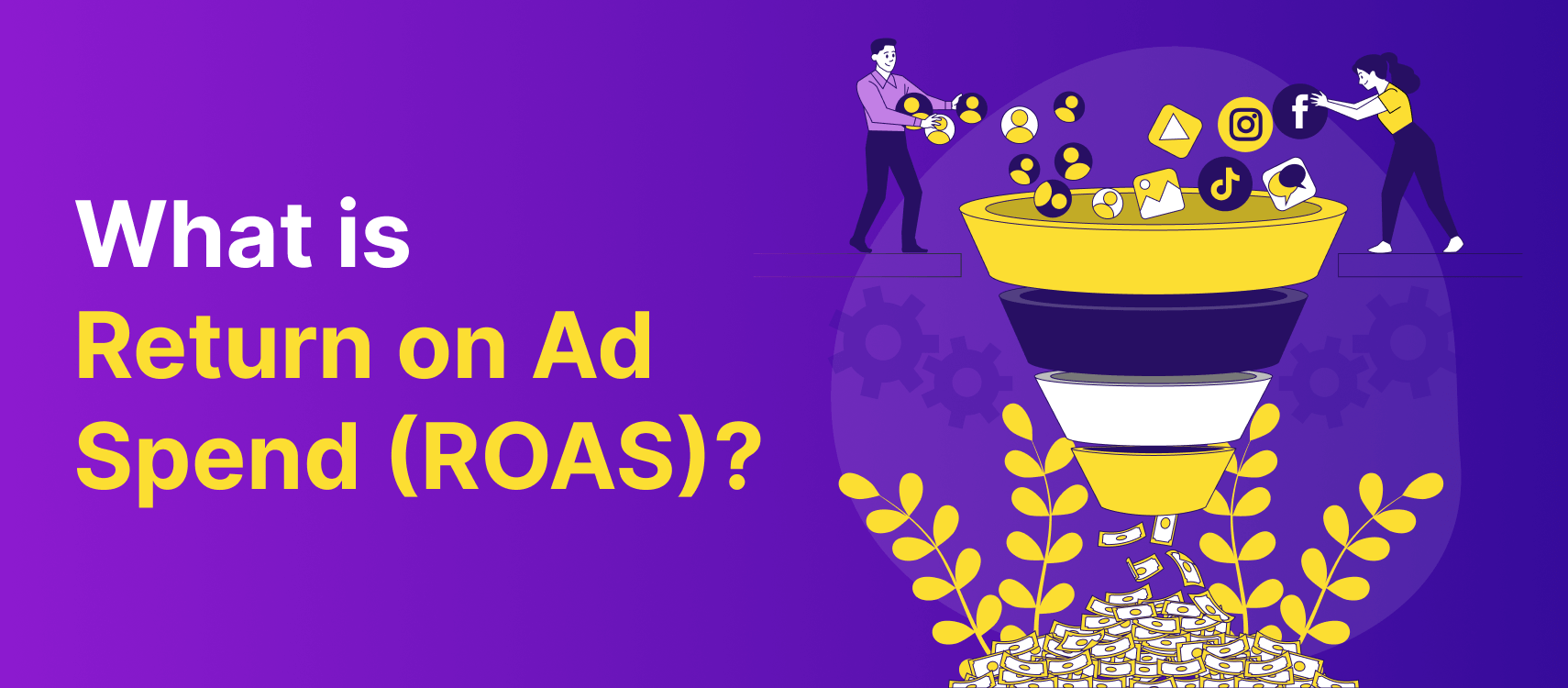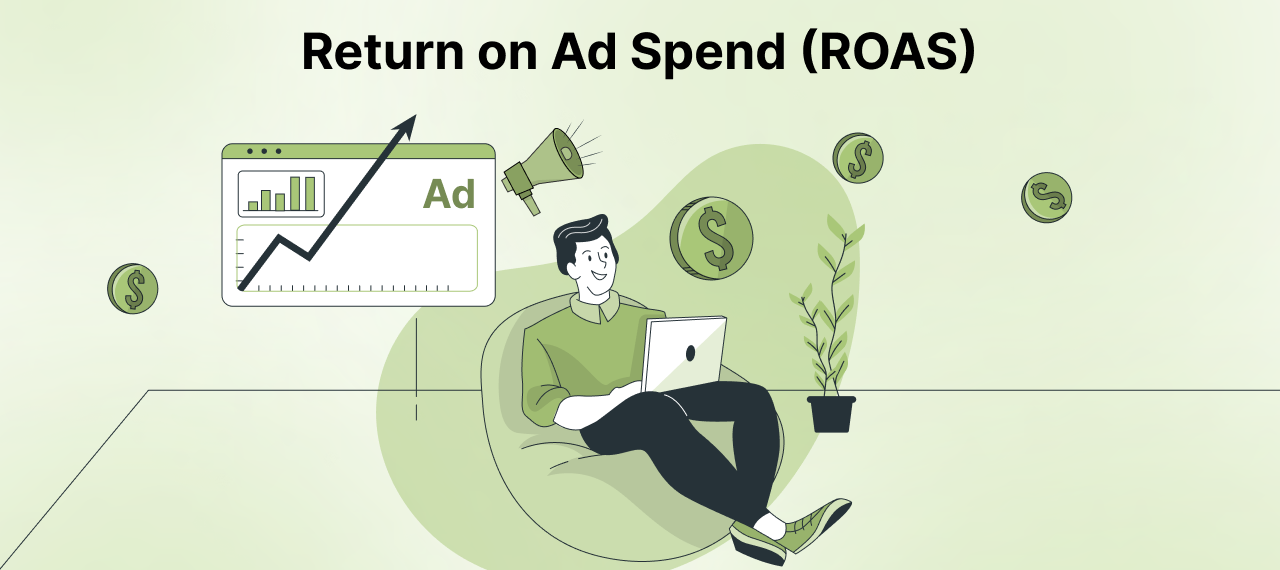Table of Contents
- What is ROAS
- Why Is ROAS Important
- Pros and Cons of ROAS
- What Is a Good ROAS
- Comparing ROI to ROAS
- What is Target ROAS
- Conclusion
- FAQs About ROAS Marketing
If you’re spending on digital ads, you need to know what you’re getting back. That’s where ROAS Return on Ad Spend becomes your most powerful metric. Whether you’re running paid ads on Google, Meta, or any other platform, ROAS helps you track exactly how much revenue your campaigns generate for every dollar you spend.
In this guide, we’ll break down everything you need to know about ROAS marketing from what it means, why it matters, how to calculate it, and how it compares to other marketing metrics like ROI, CPA, and LTV. You’ll also learn how to set realistic ROAS goals, what a “good” ROAS looks like for your business, and how to improve it over time with the right strategies.
Whether you’re a startup, an eCommerce brand, or a marketing agency, mastering ROAS will help you make smarter ad spend decisions, boost profitability, and fuel sustainable growth.
What is ROAS?
Ever wonder if your ads are really paying off? That’s where ROAS (Return on Ad Spend) comes in. It tells you how much money you’re making for every dollar you spend on ads. Simple, clear, and super powerful. Whether you’re trying to grow your sales or make the most of your budget, understanding ROAS helps you focus on what works-and drop what doesn’t. Ready to make smarter marketing moves? Let’s break it down.
Think of it like this: if you spend money on ads, ROAS tells you if that spending led to more money coming into your app.
Example:
If you spent $1,500 on ads and made $6,000 in revenue, your ROAS is 4:1. This means for every $1 you spent, you earned $4 back. You calculate it like this:
$1,500 (ad spend)$6,000 (revenue)=4 or 4:1 (ROAS)
A higher ROAS usually means your ad campaign is performing better. It helps you decide where to spend more money and what might not be working.
ROAS is helpful, but it’s also important to consider other factors. For example, look at how much it costs to acquire a new user (CPA) and how much money a user spends over time (LTV). This will give you a better understanding of your app’s performance.
Basically, ROAS is like a specific way to measure the return on your ad investments for your app.
Why is ROAS important?
ROAS (Return on Ad Spend) is important because it serves as a key performance indicator (KPI) that helps brands understand the revenue generated from their advertising investments. It provides early insight into the effectiveness and profitability of an ad campaign. For businesses, especially in online retail, monitoring ROAS enables marketers to optimize their digital marketing strategies and allocate budgets more efficiently, ensuring maximum return for every dollar spent.
What is a successful ROAS?
Determining a successful ROAS depends on several factors, such as industry, profit margins, and business goals, which makes it difficult to set a universal benchmark. Generally, brands aim for a higher ROAS ratio, indicating more revenue earned per dollar spent on ads. As a rough guideline, a 3:2 ROAS means a brand earns $3 in revenue for every $2 spent on advertising, which is slightly above the current industry average. However, the ideal ROAS is often higher; brands typically target ratios closer to 4:1 or 5:1 to ensure strong profitability and growth.
How to Calculate and Express Return on Ad Spend (ROAS)
Return on Ad Spend (ROAS) is a key performance metric that tells you how much revenue your advertising efforts are generating relative to what you spend. Whether you’re running campaigns on Google, Meta (Facebook/Instagram), or any other platform, tracking ROAS gives you clear insight into ad performance and profitability.
The ROAS Formula
The standard formula for calculating ROAS is:
ROAS = Revenue Attributable to Ads ÷ Cost of Ads
Example:
If you spend $1,000 on an ad campaign and it generates $3,000 in revenue, your ROAS would be:
$3,000 ÷ $1,000 = 3
This means for every $1 you spent on ads, you earned $3 in return.
How to Express ROAS
You can express ROAS in two ways:
- As a ratio:
- Example: 3:1
- Meaning: You made $3 for every $1 spent.
- As a percentage:
- Multiply the ratio by 100.
- Example: 3 × 100 = 300% ROAS
- Meaning: A 300% return on your ad spend.
Both formats are widely used. Use ratios for quick executive summaries and percentages for detailed reporting or financial analysis.
What Counts as ‘Ad Spend’?
ROAS accuracy depends on how you define “cost of ads.” There are two main approaches:
Basic ROAS (Platform Ad Spend Only):
Only includes direct ad spend on platforms like Google Ads, Meta Ads, or LinkedIn.
Comprehensive ROAS (All Associated Costs):
Includes all related expenses:
- Ad platform spend
- Agency or freelancer fees
- Creative production costs (graphics, videos, copy)
- Team salaries or time spent managing campaigns
- Marketing software or tools used for ad delivery
This comprehensive view gives you a more realistic understanding of campaign profitability, especially for high-budget or complex campaigns.
Why Is Return on Ad Spend Important?
ROAS is a crucial metric for measuring how well your ad campaigns are performing and how much value they’re bringing to your online store. It helps you understand exactly how much revenue you’re making for every dollar spent on advertising.
Combining ROAS with customer lifetime value (LTV) gives you better insights into your campaigns. This helps you make smarter decisions about where to spend your marketing budget.
By tracking ROAS regularly, eCommerce businesses can see which ads are performing the best. This allows them to adjust their marketing strategies and use their budget more effectively.
Pros and Cons of ROAS
Here’s a breakdown of the pros and cons of ROAS in a more user-friendly way, avoiding jargon and focusing on simple explanations:
Pros of Using ROAS
- Measures Advertising Efficiency
ROAS directly shows how much money you make for every dollar spent on ads. It’s a simple way to answer the key question: “Are my ads making money?” - Easy to Understand and Calculate
The formula is simple: Revenue ÷ Ad Spend. This makes it easy for anyone, from marketers to business owners, to understand how well campaigns are performing. - Helps with Budget Decisions
By identifying which campaigns are performing well with a strong ROAS, you can confidently allocate more budget to them. You can also reduce spending on campaigns that are less successful. - Optimizes Campaigns
Tracking ROAS at different levels, like individual ads or campaigns, helps you see what’s working best. This allows you to make adjustments and improve results. - Supports Goal Setting
ROAS gives you a concrete number to set performance targets. You can compare current performance to past results or industry averages. - Focuses on Revenue
Unlike metrics that just show clicks or impressions, ROAS links your ad efforts directly to actual revenue, making it a key business metric. - Compare Advertising Channels
You can use ROAS to compare which platforms (like Facebook, Google, etc.) are giving you the best return on investment, helping you focus on the most effective channels. - Improves Bidding Strategies
Knowing your ROAS for different segments (like keywords or audiences) helps optimize your bidding strategy, ensuring you’re getting the most value from your spend.
Cons of Using ROAS
- Doesn’t Include All Costs
ROAS only looks at ad spend and revenue. It doesn’t account for other expenses like production costs, shipping, or customer acquisition, meaning a high ROAS doesn’t always mean your business is profitable. - Ignores Long-Term Value
ROAS mainly focuses on immediate sales. A lower ROAS might still be worth it if it brings in customers who will buy from you again and again. ROAS doesn’t capture this long-term customer value. - Short-Term Focus Can Be Misleading
New campaigns or those aimed at building brand awareness may start with a low ROAS, but they can lead to bigger returns over time. Relying too much on short-term ROAS might cause you to miss out on long-term opportunities. - Doesn’t Show the Full Customer Journey
ROAS typically only counts the last click or ad that led to a sale. It doesn’t consider all the other steps (or ads) that contributed to the purchase. - External Factors Can Affect ROAS
Things like holidays, economic shifts, or competitor actions can impact your ROAS, making it hard to tell if your ad campaign is truly performing as well as it seems. - Not Always Relevant for Every Campaign
ROAS might not be the best metric for campaigns that aren’t focused on direct sales, like those for brand awareness, app downloads, or lead generation. - Requires Accurate Tracking
If your ad spend or revenue tracking isn’t spot on, your ROAS number will be incorrect. Accurate data is critical to making informed decisions. - Can Lead to Short-Term Thinking
Focusing too much on boosting ROAS in the short term could distract you from building long-term customer relationships or brand loyalty.
What is the Difference Between ROAS and ROI?
ROAS (Return on Ad Spend) and ROI (Return on Investment) are both performance metrics, but they serve different purposes and measure profitability from different perspectives.
| Focus | Definition | Formula | Focus |
| ROAS | Measures how much revenue is generated for every dollar spent on advertising. | ROAS = Revenue from Ads ÷ Cost of Ads | Focused on ad performance only. |
| ROI | Measures overall profitability after all costs (including product, ad, team, etc.) are considered. | ROI = (Net Profit ÷ Total Investment) × 100 | Focused on total business profitability. |
What is the Difference Between ROAS and ACOS?
ROAS and ACOS (Advertising Cost of Sale) are two sides of the same coin; they both measure ad efficiency, but are expressed differently.
| Metric | Definition | Formula | Expression |
| ROAS | How much revenue is earned per dollar spent on ads. | ROAS = Revenue ÷ Ad Spend | Expressed as a ratio or percentage (e.g., 4:1 or 400%). |
| ACOS | What percentage of your revenue was spent on ads. | ACOS = Ad Spend ÷ Revenue × 100 | Expressed as a percentage (e.g., 25%). |
What Is a Good Return on Ad Spend (ROAS)?
An acceptable ROAS depends on factors like profit margins, operating costs, and the overall health of the business. While there’s no definitive answer, a typical benchmark is a 4:1 ratio $4 in revenue for every $1 spent on ads. Start-ups with limited cash flow may need higher margins, while growing online stores might be able to handle higher ad expenses.
Some businesses need a 10:1 ROAS to remain profitable, while others can grow with just a 3:1 ratio. A company can determine its ideal ROAS once it has a clear budget and a solid understanding of its profit margins. Businesses with larger margins can afford a lower ROAS. However, businesses with smaller margins need to keep advertising costs low and aim for a higher ROAS to stay profitable.
Comparing ROI to ROAS
When developing a marketing campaign, calculating ROI is crucial, but it’s not the whole picture. While ROI helps you understand overall profitability, it doesn’t give you a clear answer on whether a campaign will succeed. That’s where ROAS (Return on Ad Spend) comes in. ROAS not only shows potential profitability, but it also reveals which specific tactics are most effective in driving sales. By focusing on these proven strategies, you can apply them across different marketing efforts and attract new customers for the long run.
ROAS, unlike ROI, doesn’t focus on overall profitability. Instead, it zooms in on the specific strategies that work. To build a successful digital advertising campaign, it’s important to consider both ROI and ROAS. By doing so, you can make quick adjustments and boost your returns even further.
What is Target ROAS
Target ROAS is a bidding strategy designed to reach a specific value you set. Essentially, it helps you determine the target order value for every dollar spent on your campaign.
Unlike other AdWords bidding strategies where Google automatically manages bids, Target ROAS requires you to set your own bid strategy. This is because there’s no standard approach.
Target ROAS can be especially helpful in certain industries, like eCommerce, where the goal is to drive in-app purchases. However, keep in mind that it requires a minimum number of conversions Google recommends at least 15 conversions in the last 30 days within the same campaign. Without enough conversions, it can be challenging for Google to reach your target.
Conclusion
To sum it up, Return On Ad Spend (ROAS) is crucial for e-commerce success in 2024 and beyond. By staying updated on ROAS trends, following best practices, and using new technologies, businesses can improve their ad strategies. This leads to more sales and helps attract more customers.
With a clear action plan and priorities, businesses can handle challenges and make the most of ROAS opportunities. By focusing on customer experience, personalization, and seamless integration across channels, businesses can boost their ROAS and stay competitive in the ever-changing e-commerce market.










